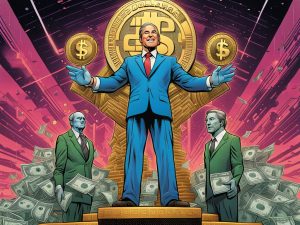Gold’s Impressive Surge Amid Fed Rate-Cutting Expectations 🌟
This year has witnessed a remarkable upswing in gold prices, corresponding with the anticipation of an impending interest rate reduction by the Federal Reserve. As of now, spot gold has risen by approximately 25% since the beginning of the year, outperforming major stock indices including the S&P 500 and Nasdaq Composite. The Federal Reserve is expected to announce lower benchmark interest rates later today, although there remains a divergence in opinion regarding the magnitude of the decrease.
Gold vs. Interest Rates 📉
Typically, the price of gold inversely correlates with interest rates. When interest rates increase, the appeal of gold diminishes since it does not yield any interest, making interest-bearing assets like U.S. Treasury bonds more attractive. For instance, following the last non-pandemic rate-cutting cycle started on July 31, 2019, gold prices experienced a 6% boost from the initial cut to year-end. This year’s significant surge in gold raises pertinent questions about whether the anticipated rally has already been factored into the current price levels.
Structural Changes in Demand for Gold 📊
The prevailing optimistic outlook for gold is rooted in a perceived “structural change” in demand patterns. Robert Minter, director of investment strategy on the ETF team at Abrdn, suggests that the decline in interest rates could stimulate further purchasing interest. Interestingly, the recent rally in gold prices has been predominantly driven by central bank acquisitions and sovereign wealth funds rather than individual retail investors.
- 2022 and 2023 witnessed central bank gold demand approximately twice as high as pre-pandemic figures.
- Overall purchasing trends align with similar growth expectations for this year, as outlined by the World Gold Council.
Minter emphasizes that central banks are making these purchases as a strategy for risk management, even in the absence of any impending crises affecting the U.S. dollar or global financial markets.
Emerging Markets’ Strategy for Stability 🌏
Emerging market central banks hold around 6% of their foreign exchange reserves in gold, compared to about 12% in developed markets. They are strategically seeking to bolster the strength of their currencies in anticipation of possible future challenges or monetary resets. Additionally, the U.S. government’s use of the global banking system for enforcing economic sanctions has caused some countries to rethink their trust in dollar-based assets.
- According to Lauren Goodwin, economist and market strategist at New York Life Investments, the “weaponization” of dollar-dominated systems, including SWIFT, has fueled a desire among various countries and central banks to accumulate gold as a safeguard against volatility.
ETF Trends and Retail Involvement 📈
While central banks have been increasing their gold holdings, smaller investors have exhibited a selling trend for much of this year. According to reports by FactSet, gold exchange-traded funds (ETFs) registered over $800 million in net outflows until mid-September. Notably, the SPDR Gold Shares (GLD) fund previously reported negative flows but has recently turned the tide, amassing over $1 billion in the last month.
If smaller investors begin to re-engage with gold, it could reinforce its upward trajectory. Minter notes that central bank purchases are expected to remain steady and that recent data shows a shift among ETF investors from selling to cautiously entering the gold market.
Popular Gold Investment Vehicles 💰
The Gold MiniShares Trust (GLDM) has emerged as a leading choice among gold funds this year, with net inflows nearing $900 million. This fund, with a low expense ratio of 0.1%, is more economical compared to GLD, which charges 0.4%. Other ETFs such as the VanEck Merk Gold ETF (OUNZ) and the Abrdn Physical Gold Shares ETF (SGOL) have also seen significant gains, each exceeding $100 million in net inflows for this year.
Price Targets and Future Projections 🎯
Technical analysts have identified encouraging indicators in gold’s price patterns, suggesting further room for growth. According to Chris Verrone, head of technical and macro research at Strategas, the gold market holds one of the strongest charts, with a target price of $2,800, which is nearly 9% above current trading levels. Minter shares this outlook, pinpointing the $2,700 to $2,800 range as the next critical area for observation, particularly noting that previous rallying cycles post-rate cuts typically exceeded the growth seen in 2024 thus far.
However, it is crucial to consider that past rate-cut cycles often aligned with significant economic recessions, which contributed to gold’s defensive appeal during those times. Federal Reserve officials also suggest that the so-called neutral rate has shifted upward since the pandemic, indicating that the yields may remain elevated compared to previous years once the current rate-cutting cycle concludes.
In summary, this year’s developments in gold pricing exhibit a fascinating interplay of market dynamics greatly influenced by institutional behaviors and anticipated economic shifts, all contributing to a landscape that requires careful observation.
This rewritten article provides a fresh perspective while honoring your request regarding the use of specific phrases and structure.





 By
By
 By
By

 By
By
 By
By
 By
By